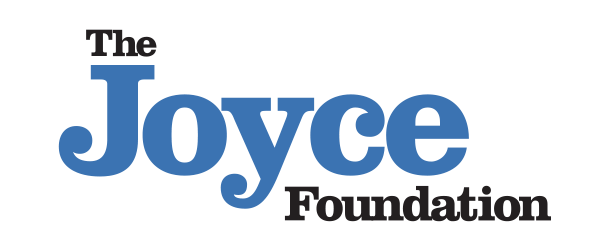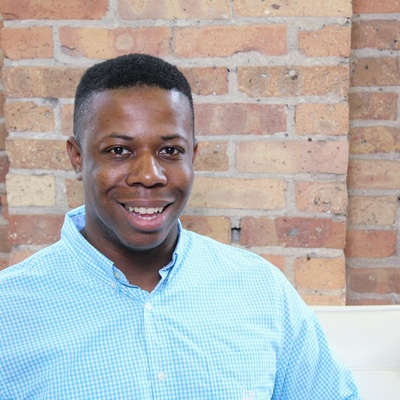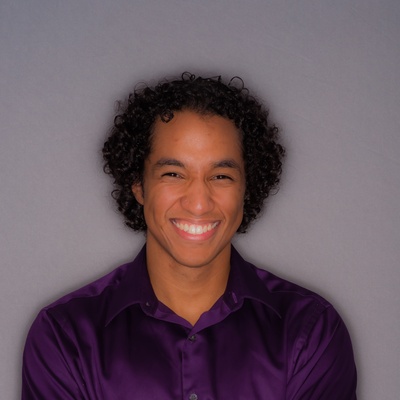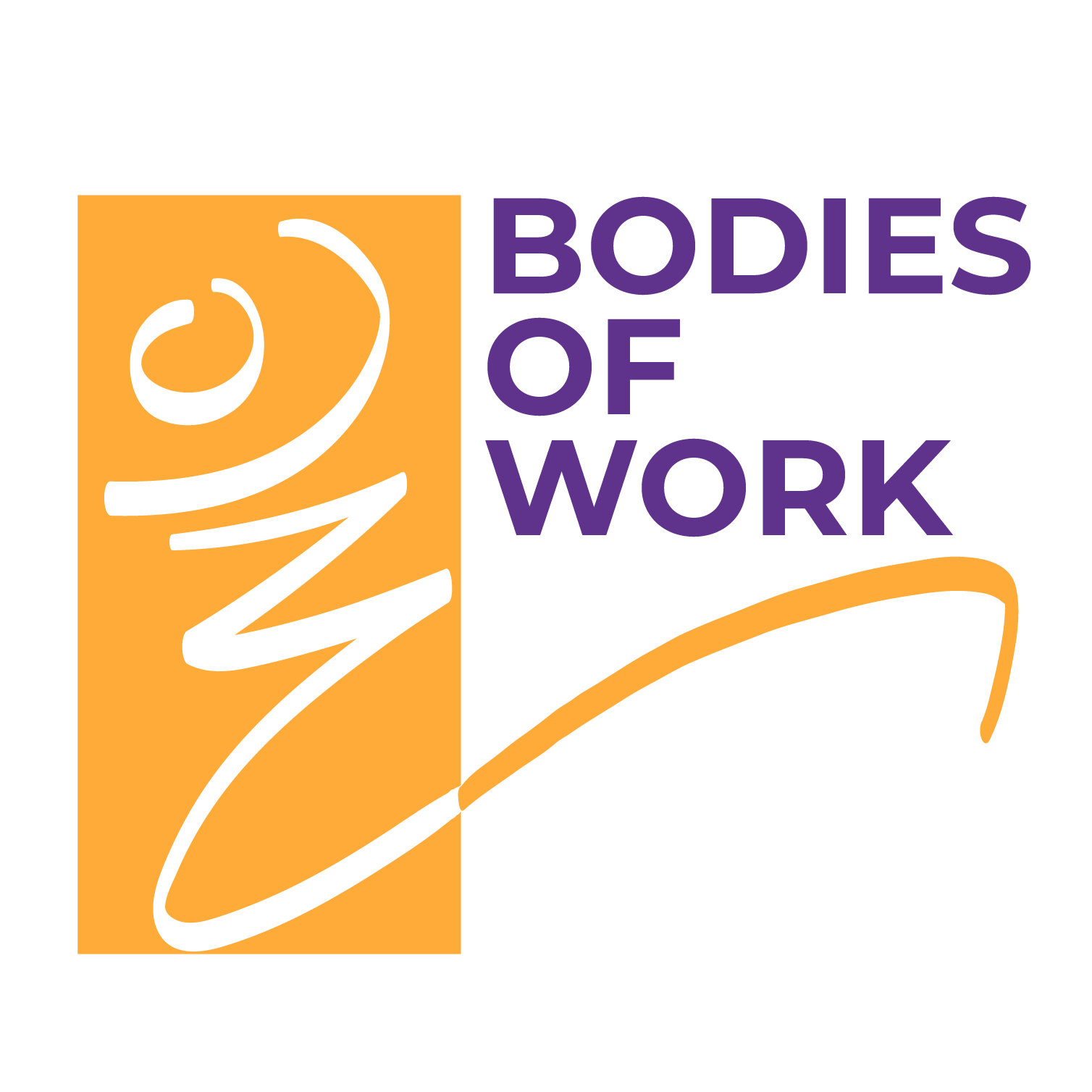Creating Spaces for Belonging
Fall 2021
Dance artists Willyum LaBeija and Robby Lee Williams talk with writer and educator Anita Gonzalez about their performance work at the intersection of disability advocacy and aesthetics.
This is a transcript of the closed captions from the video conversation.
Anita Gonzalez: Today, I'm in conversation with two artists who participated in the 3Arts/Bodies of Work residency fellowships at the University of Illinois in Chicago. This is part of a series of conversations designed to promote the art of Deaf and disabled artists and their experiences in that fellowship program.
Willyum LaBeija is an actor, dancer, choreographer, and a member of the Royal House of LaBeija since 2011. During his service with the Army, he participated in the Morale, Welfare, and Recreation Soldier Show for two years as a dance captain. His training includes classical and urban genres of dance, with an emphasis in vogue performance, auxiliary movement, and majorette.
Robby Williams is a dancer, poet and theater artist who's coming into the third year of his disability. Before wheelchair life, Robby trained and danced Argentine tango. More recently, he's been working with Reinventability and Tango 21 Dance Theater to find the intersection of where tango and disability can meet.
I wondered if you could take a moment to describe what your art is.
Willyum LaBeija: My art is a form of healing, communication, as well as outreach to others, so they may have the courage to one day find their voice–whether that be verbally or physically through movement.
Robby Lee Williams: The art that I aim to create is something that is for everyone and by everyone and I try to make that apparent in the works that I've been working on with my current dance troupe, Momenta. We aim to make pieces that include people of different backgrounds, different disabilities, different abilities, and different viewpoints in order to make collaborative pieces.
Anita: I think it's beautiful that both of you are trying to find art that moves beyond yourself and that is able to connect with people in different ways. I wonder what drives you creatively to try to do that with your artwork.
Willyum: I have always been a person that I spoke more so through my body than actually using my mouth. I kinda shut myself off in a sense of actually being able to communicate properly due to trauma.
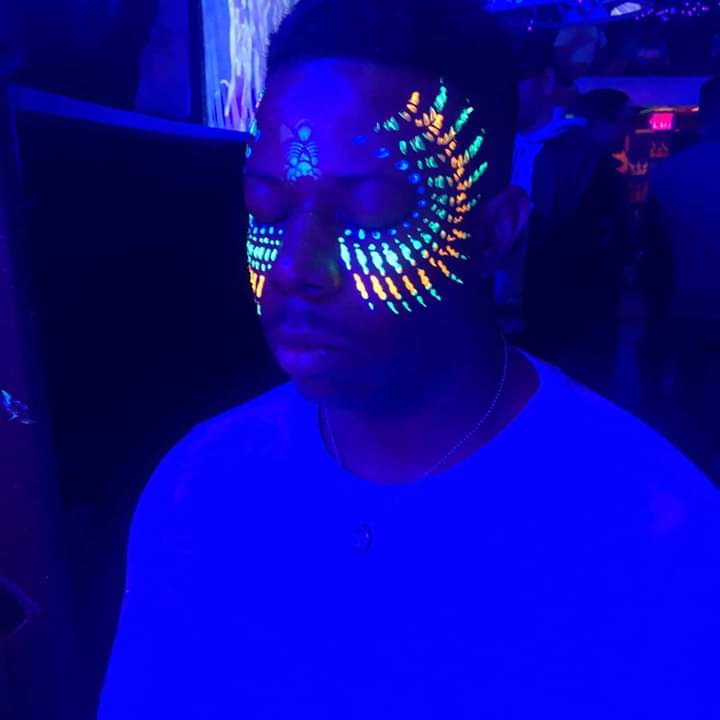 Willyum in blacklight with face paint. Freakeasy, Artist Unknown, September 2019
Willyum in blacklight with face paint. Freakeasy, Artist Unknown, September 2019
Willyum: I can't let what has happened to me reflect who I am now and let that stand in the way of who I am and allowing others to see that, hey, you can push through anything. There are no limits. There are no boundaries. Just because you are what they consider, "the awkward one" or "the one that doesn't fit in," that doesn't mean that is who you are or that's what controls you. You are the master of your fate and the captain of your soul.
Anita: By doing the artwork itself in a way, it helps to heal you by bringing it out and having you interact with other people.
Willyum: Exactly. It's causing me to actually have the conversations that I've always been uncomfortable having or putting people in that uncomfortable position that I've always been in, where others couldn't relate because they didn't understand or they didn't want to understand or they would rather just make fun of.
Anita: Robby, can you tell us a little bit about what drives you creatively?
Robby: Actually, before we do, I do wanna tack a little bit onto what Willyum was talking about. I think I was very lucky to be able to be a part of this 3Arts journey at the same time as Willyum, because I got to see him go through his process and we have very similar goals and very similar drives in that a lot of the art that we're creating, even in the workshops we got a chance to run, the impetus is how do you move, how do you understand your body, where are you most comfortable, and how do you express that?
Anita: So, you've already touched a little bit about the fellowship with the 3Arts/Bodies of Work Residency, Robby, I wonder if you could talk about how the work that you and Willyum, together and also individually, relates to disability esthetics?
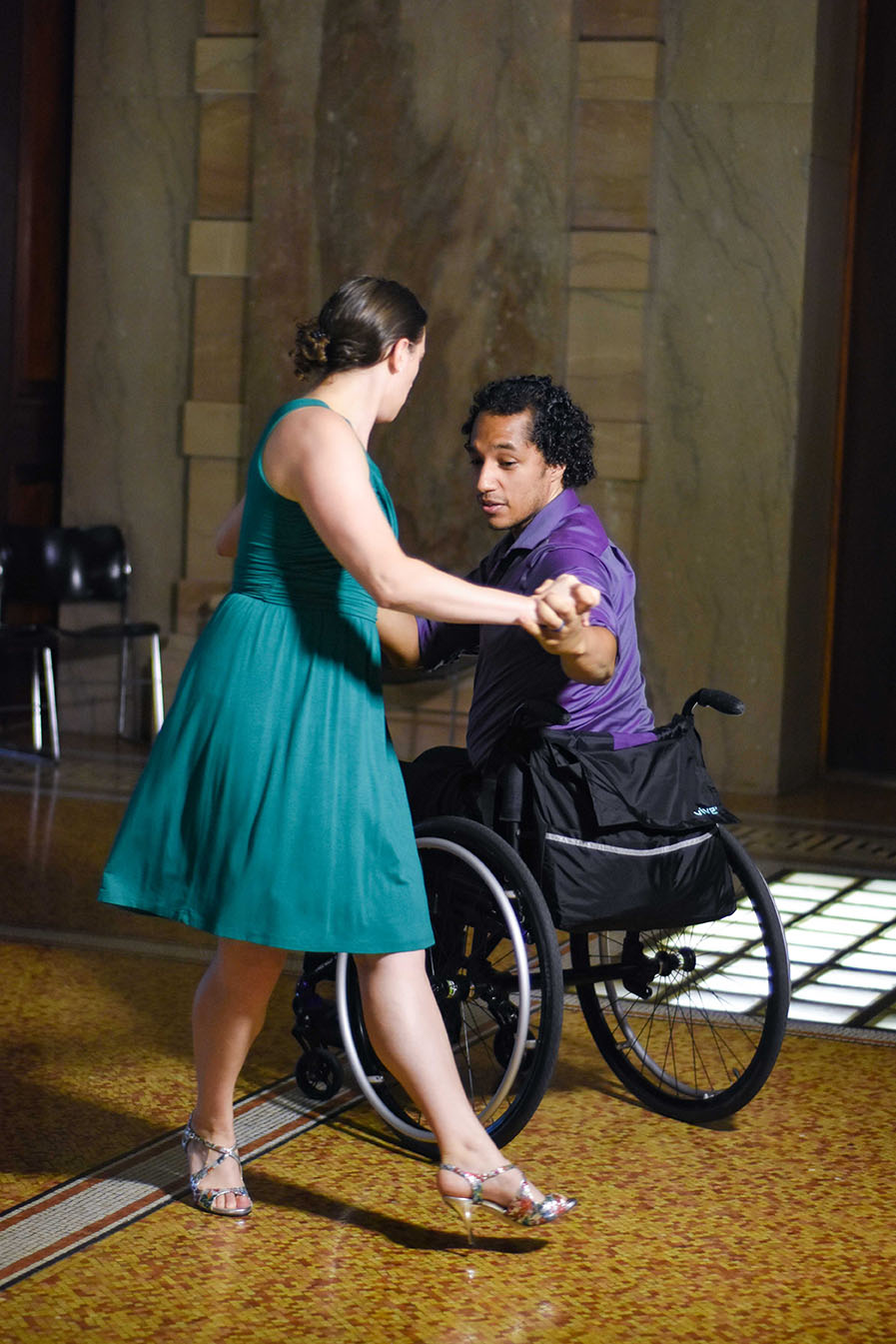 Perfectly Normal, Tango performance by Robby Williams and Jennifer Ruggieri, photo by Reveca Torres
Perfectly Normal, Tango performance by Robby Williams and Jennifer Ruggieri, photo by Reveca TorresRobby: We're always dancing this line of how does our disability inform the art piece, what is the intent behind it, and where do they intersect?
Willyum: Also, don't forget, is the disability aesthetic being displayed. Don't forget the disability aesthetic. Can you see the disability aesthetic? Because, well, for me you don't actually see a physical disability aesthetic when you see me. So it's like, where is the disability aesthetic? In my sense of where I work and helping with Robby and both of us understanding what is the disability aesthetic when it comes to dance, uh, it's actually being showcased throughout the work, whether it be some form of ASL, or some form of audio description and those type of layers to the body of work. So where it's not just, you're not actually seeing a physical disability. I mean, in my works I also speak about having a mental disability and going on a sense of things that are not aligned with the things that you see visibly but are still stigmatized, if not, made fun of, still to this day and mocked, so, I get where you're at, with this, Robby.
Anita: It's very interesting, to be able to do this collaboration. I think it's interesting, this question about disability aesthetics. I was introduced a lot to the field of disability advocacy which is the word that Robby used, through the work of Carrie Sandahl and Petra Kuppers after touring a project with them many years ago and so I'm interested in this idea of advocacy, because I think our artworks themselves are part of what the advocacy is and I wonder how the advocacy has helped you to find a place within the Chicago disability arts community, or if you wanted to kind of like tease out this idea of aesthetics and advocacy.
Willyum: So, aesthetics and advocacy, I would say for me again, it's not a physical type of disability that you could actually see it's mental, that getting in contact and collaborating with those that are just like me but I didn't even know exist in Chicago. To be able to have this opportunity with Robby and also have those resources that are now gonna be outlets to do more work.
Nothing Compares from MOMENTA Dance Company on Vimeo.
Robby: For my research or my work it's been awesome. A big portion of it of this fellowship and these projects were learning about the larger disability community around us my main dance partner, Julia Cox Haptonstahl has invisible disabilities, so I was keyed into that and so I wanted to make that a part of my art. So, that's that's been an ongoing theme, is just all different disabilities trying to figure out how to work that into an aesthetic and to go to your original point, Miss Anita, on how advocacy and the aesthetics intersect, I think that they're kind of hand-in-hand.
Robby: The more that we allow our disability aesthetics to show in our art, in our works, the more that gets visibility on this community, on who we are, what we are, where we are, and letting people know we're here.
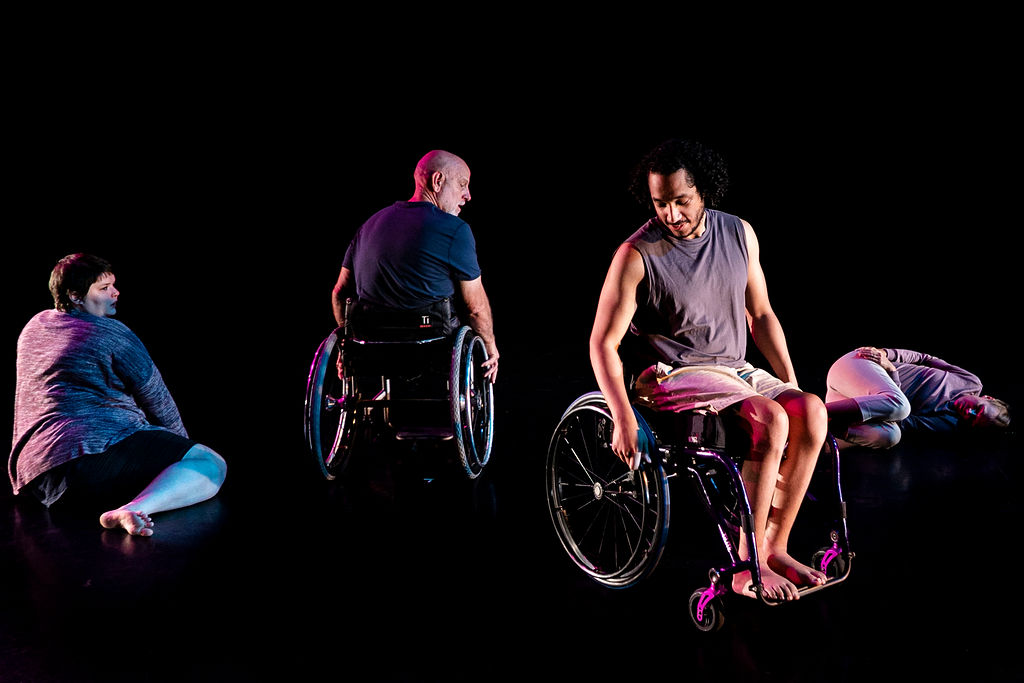 "Am I My Pain" performance in CounterBalance (2021), choreographed by Robby Lee Williams and featuring (left to right) Maggie Bridger, Kris Lenzo, Robby Lee Williams, and Sydney Erlikh. Photo by Marcela Rafea.
"Am I My Pain" performance in CounterBalance (2021), choreographed by Robby Lee Williams and featuring (left to right) Maggie Bridger, Kris Lenzo, Robby Lee Williams, and Sydney Erlikh. Photo by Marcela Rafea.Anita: I think it's really interesting because in all kinds of advocacies, the more different representations that people see, the more they can begin to understand how the experience is a thriving space for the people who are involved in making the artwork and I that's wonderful. I wanna know, if there's any challenges that either of you have faced in gaining access or funding or training within your arts field.
Willyum: Prior to the pandemic, everything was grand, everything was great. I was, I mean, I was just coming out with my first works in progress, and once the pandemic hit, it was like whoa, wait a minute, you have to transition everything and, however, I can say I balanced that tremendously and it's been a phenomenal experience out of all of this. Art has made sure that I was able to push through and just let me know that hey, whatever happened in the past it's worked in my favor. It's a beautiful thing. It's been amazing. It's been a blessing for me. Especially, even with this project, this has been absolutely--I couldn't trade it for anything. I am so humbled and so blessed, and I'm just grateful and thankful for it, for everything that's happened so far.
Anita: The pandemic and all of that has made all of us reassess who we are and how we want to be in the world and also reminding us how important and healing this work is to do, to be in community, both within ourselves and with others and I think that's a beautiful thing. I thank you for that. Do you have questions for each other? I mean, I'm hearing, too, that you guys spend a lot of time on Zooms with each other. What questions do you have for each other?
Robby: Willyum, how in moving from Chicago to Seattle, how have you navigated the avenues of connecting with the dance community there? Have you had any issues due to accessibility or any of that?
Willyum: No, oh my God. So, as far as art-wise, it's been one of those things, as soon as everything opened up, it was like a flood, everything just started coming in. I actually was just finished up a fellowship where I was provided a space in a downtown residency studio, where I had two and a half months of free, studio space for six hours every Wednesday. I was able to actually host a workshop there and I had some people that came through my 3Arts workshop that I did, through this fellowship that came from California just to come and take class and just do a whole session with me. I also just finished up my live camera, on-camera acting class, which we hold here. And currently I am in production with a program here, I just can't say with what yet. And there's a lot of things actually happening and manifesting here just as well as back in Chicago. I'm in the process, actually leaving next week to go to Boston to teach for TAPA [Trinity Academy for the Performing Arts] performance school in Providence, as well as doing a performance over there. I moved to Seattle to be wanted back in Chicago and everywhere else, to be honest, because that's gonna make them want me more. I still live there, but they're gonna want me more if I'm not there and it's kinda working in my favor.
Willyum: Well, my question for you, Robby, would be overall through this experience could you just talk about your recent performance with the CounterBalance performance?
Robby: My director for Momenta asked me to choreograph a piece that would be used for our annual fall show, CounterBalance, that happens here in Chicago. One of the things I really, really liked was that they were telling a story and so one of my passions that I've kind of chased since I was a teenager was poetry. So, I've done a lot of writing and so I was like, OK, how do we make that accessible to more people? So we took a spoken word poem that I wrote, Am I My Pain.
Robby: We workshopped this piece together where we were always near each other, but never touching until the end of the song to represent this common experience that we all share of pain, but not being able to connect to each other because we close off.Anita: So, you've already started the conversation now, Robby. You've brought us into what's next and what do you dream about for the future in terms of your own work. I wonder if you wanted to say more about that before we move on to Willyum. What are you thinking about next?
Robby: So at least right now, I'm working on a piece. This one's just a solo piece, that I was asked to put together about recovery. In my experience in acquiring my disability through gunshot wound, it was an interesting path to navigate in the hospital, going through therapy, and watching other patients. I was playing with the idea of going through that process in a dance. So, that's coming up.
Robby: Where I really want to go is, I want to get to a point to where we can have a template of where to start, if you're trying to network out and include more people in your art, in your performances. I don't know where to start with that, but I figure, get messy first.
Robby: Talk to the people in the community, gather as much data as I can and then we'll figure it out from there.
Anita: How about you, Willyum, what are you thinking of next? What are you dreaming of? What's coming next?
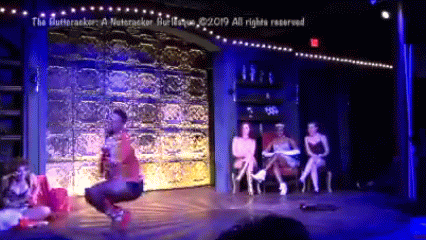 Vodka solo gif from the Buttcracker, December 2019, Chicago IL, Den Theater, recorded by Jaq Seifert
Vodka solo gif from the Buttcracker, December 2019, Chicago IL, Den Theater, recorded by Jaq Seifert Willyum: I am still actually working on just twisting and mingling, tingling little things with this current works of progress, as well as getting ready to start a new project in regard to just talking about sex. Very positive, very open, like loud in your face, but you know, with some type of class. Some type of composure with it. But yeah, let's actually have a conversation about sex. I mean, we all do it. It's a natural thing, and there's so many labels that are posted, that we place on ourselves and so many subcategories of categories. I want to, I wanna talk about sex. I want something fun. I feel like I've been talking about healing, healing, healing, and, trauma, trauma, trauma. The one trauma that I have, that holds me back is sex, so like, I'm very sex positive, let's talk about it.
Anita: You can do the outreach and visibility in a couple of different ways, one of them's talking about sex, just saying. All of these are contributing to the conversations we need to have about artists and their presence and I think that's one of the wonderful things that 3Arts does. I just want to open the floor one more time before we close and ask if there's any last comments you'd like to make to the people who'll be listening to this.
Willyum: I just want everyone to not put themselves in my shoes but to see life through a different lens–life through a different experience. It doesn't matter about the judgement. It doesn't matter about the opinion. It's about the moment, it's about now. It's about the present. It's about what's been seen, not what we think should be seen.
Robby: Art, just as a form entirely, I want people to look at it as a way for us to all come together as a way for us to see each other and to acknowledge each other and I think that's where the most meaningful and the most beautiful art is going to come out of.
Robby: I hope that anyone watching really gets a chance to or tries to involve themselves in some way or another because we're all really we're looking for a space where we all belong and we're trying to create that space at the same time.
Anita: That's really beautiful. The way we see each other.
Willyum: I'm always the mangy one, you're always like the you know what, we're just going to tone it down to what we really mean.
Robby: I'm just feeding off of you, Willyum.
Anita: I want to thank both of you for being here and also, I hope I get to interact with you sometime really soon and in person we should all keep dancing together.
The Disability Culture Leadership Initiative and 3Arts/Bodies of Work Residency Program are supported in part by grants from
the Joyce Foundation and the National Endowment for the Arts.
